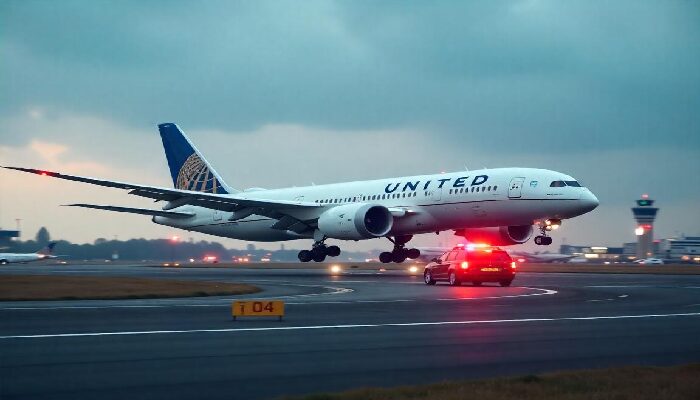Introduction
United airlines flight ua770 emergency diversion Air travel is among the safest modes of transportation, with stringent regulations, highly trained crew, and state-of-the-art aircraft ensuring that millions of passengers travel safely each year. However, even in this well-regulated industry, emergencies occasionally occur, testing the systems and personnel in place. One such incident involved United Airlines Flight UA770, which made an emergency diversion mid-flight in July 2025. While no fatalities were reported, the event drew attention due to its dramatic nature, the quick thinking of the crew, and the implications for the broader aviation industry.
This article provides a detailed look at the UA770 emergency incident, from the sequence of events and emergency protocols to the investigation and industry-wide repercussions. By exploring every facet of the incident, we can better understand how such emergencies are handled and what lessons can be learned to improve safety for all.
Understanding the UA770 Emergency Incident
On July 6, 2025, United airlines flight ua770 emergency diversion departed from San Francisco International Airport (SFO) en route to Boston Logan International Airport (BOS). The flight, operated by a Boeing 757 aircraft, was carrying 168 passengers and 7 crew members. It was expected to take approximately six hours.
Roughly two hours into the flight, while cruising over the central United States, the crew reported a mechanical issue, prompting an unscheduled diversion to Denver International Airport (DEN). According to preliminary statements from the airline and air traffic control recordings, the crew reported a pressurization fault coupled with a smoke alert in the avionics bay.
While not immediately life-threatening, the situation required decisive action. The pilots declared an emergency, initiated a descent to a safer altitude, and coordinated with Denver ATC for an expedited landing.
Timeline of Events
08:12 AM PST – UA770 departs SFO.
10:30 AM CST – Pilots detect pressurization and smoke indicator anomalies.
10:35 AM CST – Pilots declare an emergency; cabin pressure is stabilized, and oxygen masks are not deployed.
10:55 AM CST – Aircraft begins descent and reroutes toward DEN.
11:22 AM CST – Flight UA770 lands safely in Denver. Emergency services meet the plane on the tarmac.
11:40 AM CST – Passengers deplane; no injuries reported.
Causes Behind the Emergency Diversion
Preliminary information from the Federal Aviation Administration (FAA) and United Airlines’ internal maintenance logs points to a combination of avionics bay smoke alert and an anomalous cabin pressurization reading. These issues, while possibly unrelated, both warrant immediate action when detected.
Avionics Bay Smoke Alert
The avionics bay houses critical flight electronics, including navigation and communication systems. A smoke warning here is taken seriously due to the fire risk it presents. In the UA770 case, no actual fire was found, and the smoke alert was later attributed to a sensor malfunction, but this could not have been known during flight.
Pressurization Fault
Modern aircraft are designed to maintain a cabin pressure equivalent to 6,000–8,000 feet altitude. A pressurization anomaly can result from system leaks, software errors, or mechanical valve failures. While the cabin never depressurized to dangerous levels, the fluctuating pressure readings were enough to prompt an emergency response.
Mechanical Redundancy and Crew Protocols
The aircraft’s redundant systems performed as designed. The pilots followed protocol, working through checklists and consulting dispatchers and maintenance control on the ground. Their decision to divert demonstrated textbook airmanship, prioritizing safety over schedule.
Emergency Response and Crisis Management
Onboard Crew Response
The flight crew acted with professionalism and calm, keeping passengers informed while coordinating with air traffic controllers. The cabin crew remained vigilant, scanning for any signs of smoke or overheating and preparing passengers for the possibility of an emergency landing.
Ground-Based Support
At Denver International Airport, emergency response teams were notified well before the aircraft’s arrival. Fire trucks, ambulances, and maintenance crews were positioned on standby. The runway was cleared, and a priority landing slot was granted. Upon landing, the aircraft taxied to a remote stand where specialists boarded for inspection.
Communication Management
United Airlines’ crisis management team initiated their emergency communications protocol, which includes:
Informing families of passengers.
Providing updates via social media and press releases.
Coordinating rebooking and accommodations for affected passengers.
This swift communication helped mitigate misinformation and provided transparency, earning United cautious praise for its handling of the situation.
Passenger Safety and Wellbeing
Despite the alarming nature of in-flight diversions, all 168 passengers disembarked safely and without injury. Several passengers reported minor anxiety and stress but praised the cabin crew for their composed demeanor and clarity of instruction.
Passenger Accounts
One passenger, Maria Jenkins, a 34-year-old business traveler, told reporters:
“We didn’t know what was going on at first, but the crew was calm and professional. They reassured us that we were safe, and that made a big difference.”
Another traveler, who wished to remain anonymous, mentioned noticing a burning smell shortly before the captain’s announcement, though this has not been independently confirmed.
Support Services
United Airlines offered:
Hotel accommodations for delayed passengers.
Meal vouchers and transportation assistance.
Psychological support via a helpline for passengers experiencing post-incident stress.
Aftermath and Investigation
The FAA, in conjunction with United airlines flight ua770 emergency diversion and Boeing, initiated a thorough investigation. While the situation did not involve a crash or injury, any in-flight anomaly—especially one involving smoke warnings—triggers mandatory reporting and analysis.
Preliminary Findings
As of July 7, 2025:
The avionics bay smoke detector is under detailed inspection; no physical signs of fire or smoke were found.
A pressurization system valve showed signs of inconsistent operation, likely due to an electrical relay malfunction.
Black box (FDR and CVR) data has been retrieved and is under analysis to understand cockpit decisions and system behavior.
Maintenance Implications
Following the incident:
United temporarily grounded three sister aircraft from the same production batch for precautionary checks.
Boeing issued a service bulletin to all operators of the 757 regarding inspection of the avionics bay smoke detection systems.
Industry-Wide Impact and Lessons
While the incident ended safely, it has prompted broader discussions in aviation circles regarding aircraft aging, sensor reliability, and crisis communication.
1. Reliability of Aircraft Sensors
False alarms, especially in critical areas like smoke detection, can create significant operational challenges. The UA770 event serves as a reminder of the need for:
Redundant confirmation systems.
Regular sensor calibration and software updates.
Manufacturer updates on known sensor fault trends.
2. Pilot Training and Decision-Making
The successful handling of the situation reaffirms the importance of regular simulator training and scenario-based decision drills. United Airlines, like many others, incorporates emergency diversion scenarios in their flight crew training cycles. This incident supports the efficacy of such programs.
3. Public Perception and Media
Modern passengers expect real-time updates. United’s relatively fast communication—through social media and press briefings—helped reduce panic. Airlines are increasingly investing in digital crisis communication teams to handle such events swiftly.
4. Fleet Aging Concerns
The Boeing 757, while reliable, is an aging aircraft model, with production ceasing in 2004. Though well-maintained, older aircraft can present higher chances of mechanical quirks. The UA770 case may rekindle calls to retire older aircraft or accelerate fleet modernization plans.
Conclusion
The emergency diversion of United airlines flight ua770 emergency diversion on July 6, 2025, was a stark reminder that even in the safest skies, unexpected incidents can occur. Fortunately, thanks to quick thinking by the pilots, strong coordination between crew and ground teams, and robust emergency response protocols, the situation was resolved without injury.
While the causes—namely a false smoke alarm and pressurization irregularity—are still being fully examined, the outcome demonstrates the resilience of modern aviation safety systems. From the passengers’ safety to airline transparency and maintenance protocols, every layer of aviation security played a part in ensuring a safe ending to a potentially serious scenario.







